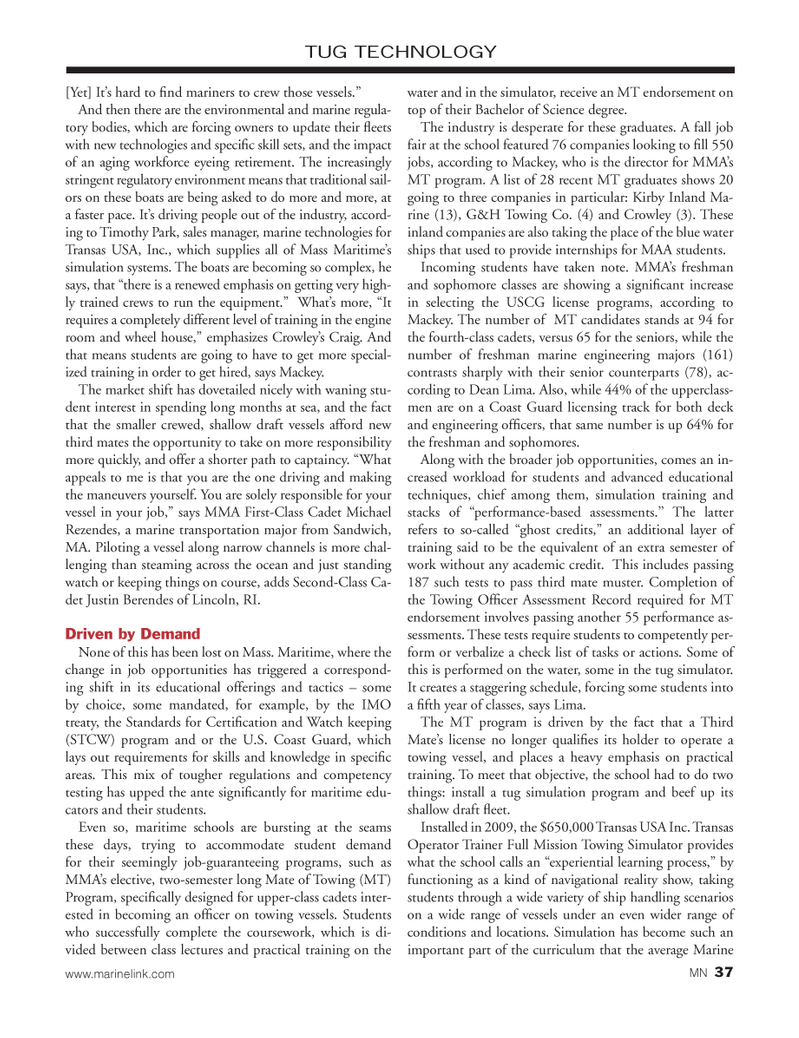
Page 37: of Marine News Magazine (January 2014)
Tug Boat Technology
Read this page in Pdf, Flash or Html5 edition of January 2014 Marine News Magazine
[Yet] It’s hard to fi nd mariners to crew those vessels.”
And then there are the environmental and marine regula- tory bodies, which are forcing owners to update their fl eets with new technologies and specifi c skill sets, and the impact of an aging workforce eyeing retirement. The increasingly stringent regulatory environment means that traditional sail- ors on these boats are being asked to do more and more, at a faster pace. It’s driving people out of the industry, accord- ing to Timothy Park, sales manager, marine technologies for
Transas USA, Inc., which supplies all of Mass Maritime’s simulation systems. The boats are becoming so complex, he says, that “there is a renewed emphasis on getting very high- ly trained crews to run the equipment.” What’s more, “It requires a completely different level of training in the engine room and wheel house,” emphasizes Crowley’s Craig. And that means students are going to have to get more special- ized training in order to get hired, says Mackey.
The market shift has dovetailed nicely with waning stu- dent interest in spending long months at sea, and the fact that the smaller crewed, shallow draft vessels afford new third mates the opportunity to take on more responsibility more quickly, and offer a shorter path to captaincy. “What appeals to me is that you are the one driving and making the maneuvers yourself. You are solely responsible for your vessel in your job,” says MMA First-Class Cadet Michael
Rezendes, a marine transportation major from Sandwich,
MA. Piloting a vessel along narrow channels is more chal- lenging than steaming across the ocean and just standing watch or keeping things on course, adds Second-Class Ca- det Justin Berendes of Lincoln, RI.
Driven by Demand
None of this has been lost on Mass. Maritime, where the change in job opportunities has triggered a correspond- ing shift in its educational offerings and tactics – some by choice, some mandated, for example, by the IMO treaty, the Standards for Certifi cation and Watch keeping (STCW) program and or the U.S. Coast Guard, which lays out requirements for skills and knowledge in specifi c areas. This mix of tougher regulations and competency testing has upped the ante signifi cantly for maritime edu- cators and their students.
Even so, maritime schools are bursting at the seams these days, trying to accommodate student demand for their seemingly job-guaranteeing programs, such as
MMA’s elective, two-semester long Mate of Towing (MT)
Program, specifi cally designed for upper-class cadets inter- ested in becoming an offi cer on towing vessels. Students who successfully complete the coursework, which is di- vided between class lectures and practical training on the water and in the simulator, receive an MT endorsement on top of their Bachelor of Science degree.
The industry is desperate for these graduates. A fall job fair at the school featured 76 companies looking to fi ll 550 jobs, according to Mackey, who is the director for MMA’s
MT program. A list of 28 recent MT graduates shows 20 going to three companies in particular: Kirby Inland Ma- rine (13), G&H Towing Co. (4) and Crowley (3). These inland companies are also taking the place of the blue water ships that used to provide internships for MAA students.
Incoming students have taken note. MMA’s freshman and sophomore classes are showing a signifi cant increase in selecting the USCG license programs, according to
Mackey. The number of MT candidates stands at 94 for the fourth-class cadets, versus 65 for the seniors, while the number of freshman marine engineering majors (161) contrasts sharply with their senior counterparts (78), ac- cording to Dean Lima. Also, while 44% of the upperclass- men are on a Coast Guard licensing track for both deck and engineering offi cers, that same number is up 64% for the freshman and sophomores.
Along with the broader job opportunities, comes an in- creased workload for students and advanced educational techniques, chief among them, simulation training and stacks of “performance-based assessments.’’ The latter refers to so-called “ghost credits,” an additional layer of training said to be the equivalent of an extra semester of work without any academic credit. This includes passing 187 such tests to pass third mate muster. Completion of the Towing Offi cer Assessment Record required for MT endorsement involves passing another 55 performance as- sessments. These tests require students to competently per- form or verbalize a check list of tasks or actions. Some of this is performed on the water, some in the tug simulator.
It creates a staggering schedule, forcing some students into a fi fth year of classes, says Lima.
The MT program is driven by the fact that a Third
Mate’s license no longer qualifi es its holder to operate a towing vessel, and places a heavy emphasis on practical training. To meet that objective, the school had to do two things: install a tug simulation program and beef up its shallow draft fl eet.
Installed in 2009, the $650,000 Transas USA Inc. Transas
Operator Trainer Full Mission Towing Simulator provides what the school calls an “experiential learning process,” by functioning as a kind of navigational reality show, taking students through a wide variety of ship handling scenarios on a wide range of vessels under an even wider range of conditions and locations. Simulation has become such an important part of the curriculum that the average Marine
TUG TECHNOLOGY www.marinelink.com MN 37
MN JAN14 Layout 32-49.indd 37 12/20/2013 10:16:56 AM

 36
36

 38
38
